A question has always nagged me whenever I read the Wheel of Time: Where are the lions? The Savanna cats are the standard of Andor, a large country with a long history and a very prominent place in the storyline. But we only see an actual lion once, in The Shadow Rising, Chapter 11, while Egwene is dreamwalking in Tel’aran’rhiod and idly observes Aiel ‘Wise One’ Amys hunt a “boar” in the Waste. Given that it’s possible to mentally create a creature in the World of Dreams, the lion Egwene saw could be merely a construct of her or the Wise One’s imagination—although to accurately imagine a lion, one would probably have to have seen one in real life. (Unless Tel’aran’rhiod can fill in the details if a Dreamwalker attempts to imagine a lion?)
So, maybe there are lions in the Waste. But this leads to more questions, because if there are lions, then surely there must be giraffes, elephants, and zebras for the carnivores to munch on. Despite fifteen books worth of adventuring, these species remain unseen. So where are ANY of the animals?
The Wheel turns and ages come and go, including our own. We don’t know how long an age on the wheel can be, but presumably it’s not long enough for a recognizable animal like a lion, giraffe, or zebra, to go extinct and then re-emerge in time to be abundant in the present day. Unless they’re all hiding in a pocket dimension, like the grolm. Which would mean that somewhere there is a pocket dimension FULL OF GIRAFFES AND…wait, where was I?
We’ve seen quite a bit of the continent that the main storyline is located on, as well as its various biomes. (Or its suspiciously non-various biomes, as some may point out.) But… there are few reports on what the Land of Madmen and Shara are like—the former being largely unexplored on account of its inhabitants sheer aggressiveness, while the latter is literally walled off and inaccessible to those outside of Sharan society. Surely some animals could live there, or even in Seanchan, a continent larger than Shara, and one that stretches from the planet’s northern icecap to well below the Equator. Geographically it’s a bit like North and South America, but more culturally homogenous. Could there be lions there? Or in Shara?
Below is my initial attempt at a worldwide bestiary. It begins with a list of animals known to exist in the Wheel of Time, then moves onto those animals that could possibly exist but are not confirmed, sorted first by continents/Named-swathes-of-land and then the possible biomes/habitats that exist in each continent, followed by a sample of animals from such a biome.
Known Animals
The Westlands (“Randland”)
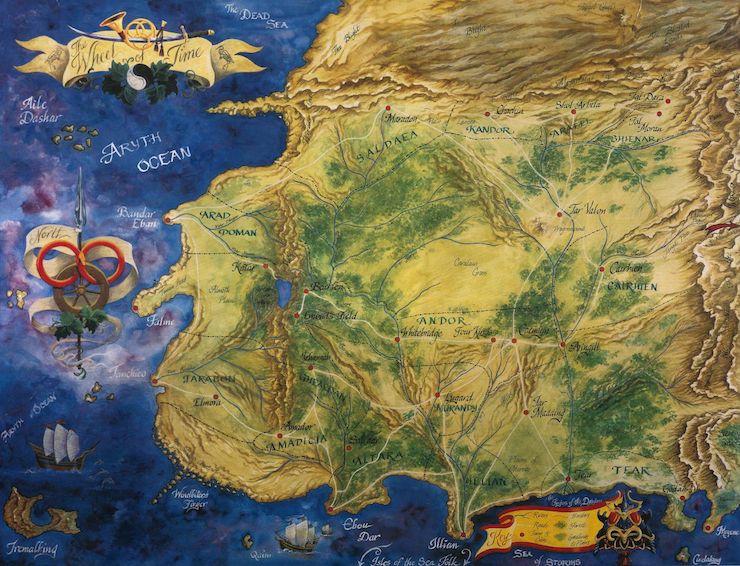
The fauna in Randland is well documented, both in the series itself and in the two non-fiction companion books The World of Robert Jordan’s The Wheel of Time and The Wheel of Time Companion, and although the majority of the story’s main continent is a forest and plains biome, the swamp/rain forest environment of the Drowned Lands adds some variety. Here are animals we’ve seen in the series or that the author has documented in companion works:
- Bats
- Bears
- “Bitemes” (Mosquitos or gnats)
- Blacklances (Snakes)
- Cats
- Deer
- Dogs
- Forkhorn (Waist-height Deer)
- Nedar (“A tusked water pig.”)
- Red Foxes
- Horses
- Rabbits
- Ravens
- Sheep
- Silverpike (Fish)
- Snakes
- Soetam (Giant rat)
- Spikehorn (Knee-height Deer)
- Swamp cat (Large mottled greenish-gray cat)
- Tropical birds
- Water Lizards (Alligators or crocodiles)
- Wolves
The Aiel Waste
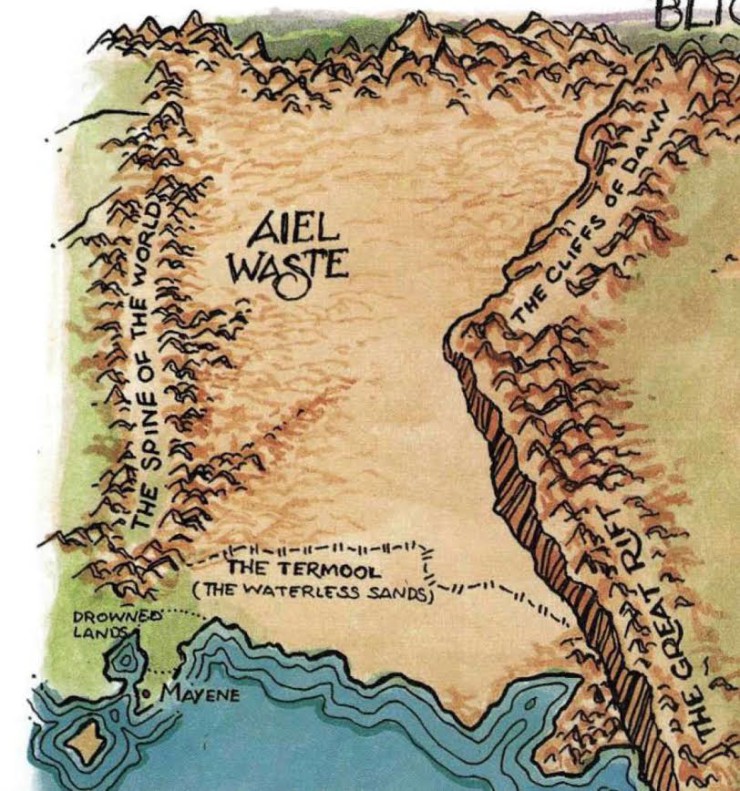
The Aiel Waste is a harsh land, badlands and scrub desert covering nearly the entirety of it. These break down into the Waterless Sands to south, becoming the ever-shifting dune desert that gives the land its name. To the West is the Spine of the World, which has three branches extending into the Waste, bringing mountainous footholds into the desert. In the North, the Mountains of Dhoom serve a similar function, although living in the foothills of the Blight is arguably suicidal. At it’s eastern edge is The Great Rift, a long canyon that extends downwards into the Earth in steep cliffs 1 to 3 miles deep, which serves as the barrier between the Aiel Waste and Shara.
The Aiel Waste is a diverse desert, holding mountains, scrub desert, badlands, canyons, and dunes. It’s highly possible that the dryness of the Aiel Waste comes from the mountains surrounding the land on three sides, which would force wet air up, collecting moisture from the sun-beaten ocean to the south and creating large storm clouds that unload their waters into Shara and Randland. Not unlike how the Himalayas push wet air up in India, forcing condensation earlier and bathing their southern slopes in rain while leaving the Tibetan Plateau dry.
Animals that we know live in the Aiel Waste:
- Bloodsnakes (Venomous Snakes)
- Capars (Boar-like animals with pointed snouts, clawed toes, and sharp teeth)
- Garas (Large Venomous Lizard)
- Mountain Kings (Venomous Snake)
- Sorda (Desert Rat)
- Two Steps (Venomous Snake)
Seanchan
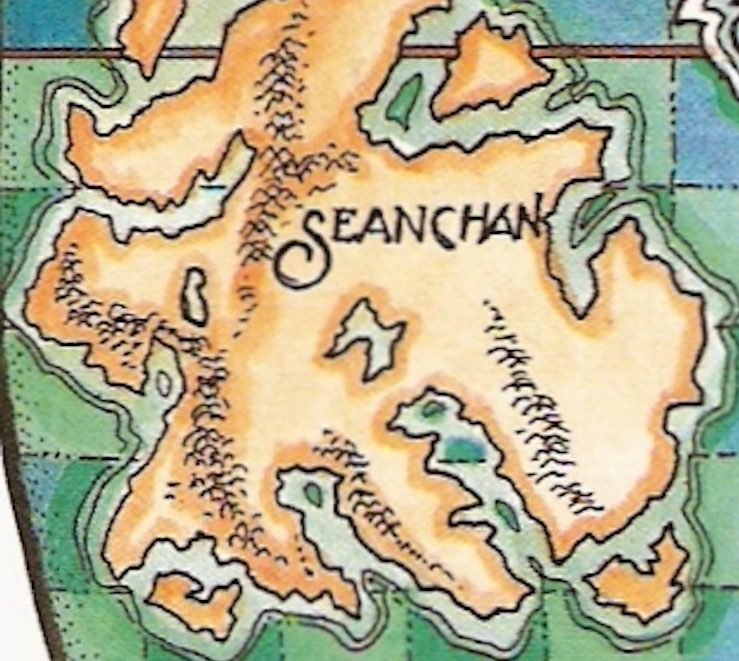
The Seanchan animals seen within the Wheel of Time are unique in that they originated in parallel worlds, presumably having been brought over by using the Portal Stones to aid in the fight against the Shadowspawn sometime in the first 1000 years after the breaking. Only the S’redit (elephants) seem to not be used for fighting on a regular basis, with the rest of the “parallel world” animals having been adopted into Luthair Paendrag’s armies after the conquering of Seanchan. These animals multiplied and became part of Seanchan’s wild ecosystem, though many are still held by the Seanchan for their army or as exotic pets and guards.
- Corlm (Large carnivorous and flightless “birds” covered with long mottled fur and a flat fan shaped tail.)
- Grolm (Likened to the appearance of a toad the size of a bear with three eyes and a beaked mouth.)
- Lopar (A hulking animal resembling a bear with a round head, they have a hairless, leathery hide. They can reach 10 feet in height standing on their hind legs.)
- Raken (Large flying animals with leathery gray skin and horned snouts, they are fast and agile fliers but are awkward on the ground.)
- S’redit (Elephants by a different name, they are similar to Asian Elephants.)
- To’raken (Larger and slower species similar to the Raken, but with a brown to reddish hide. The closest the series gets to actual dragons.)
- Torm (Fierce predators resembling large cats with three eyes, bronze scaled bodies, and six clawed paws. They’re highly intelligent and good puzzle solvers.)
Ocean
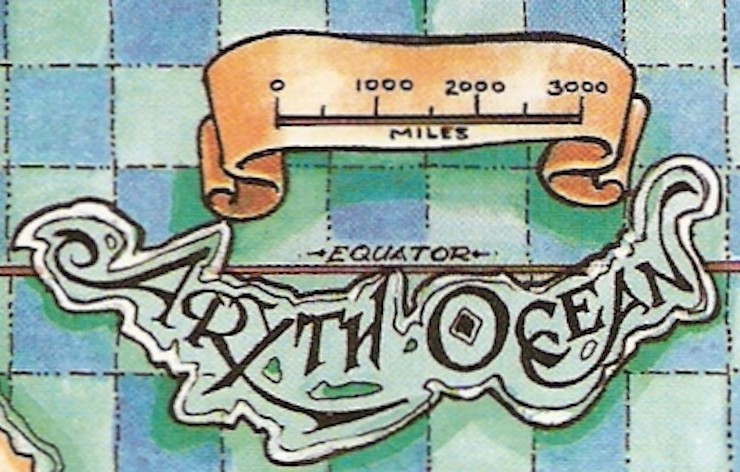
The Wheel of Time isn’t overly fond of describing its oceans, spending about as much time with them as it did with Narg, the Talkative Trolloc. (Which is to say, very little.) Aside from Suian’s constant fish-based metaphors, the only time we get to spend with The Wheel of Time’s oceans is when Nynaeve and Elayne travel on a Sea Folk ship to Tanchico and spot some dolphins following them.
- Dolphins
- Eels
- Fangfish (Possibly sharks.)
- Fish (General)
- Lionfish
- Silverpike
Assumed Animals
Randland
The Westlands are known for being covered by woods and plains—broken up by the occasional mountain range—giving an altogether very European feel. In actuality, these biomes are far more ecologically diverse than what we see in The Wheel of Time, so we can safely assume that the following animals are present in The Westlands/Randland even though we don’t really see or interact with them.
- Deciduous Forest/Woodland
- Adders
- Avian life (General)
- Badgers
- Deer
- Deer Mice
- Ducks
- Frogs
- Garter Snakes
- Hedgehogs
- Hummingbirds
- Lizards
- Opossums
- Owls
- Skunks
- Squirrels
- Swallows
- Toads
- Turtles
- Weasels
- Wild boars
- Wood Grouses
- Grassland
- Buffalo
- Coyotes
- Elk
- Golden Eagles
- Voles
- Swampland/marshes
- Bald Eagles
- Bobcats
- Boa Constrictors
- Caimans
- Crawfish
- Crocodiles
- Egrets
- Frogs
- Geese
- Herons
- Marsh Flies
- Toads
- White Tailed Deer
- Mountains/Rivers
- Fish (General)
- Fresh Water Shrimp
- Hawks
- Meadow Mice
- Mountain Goats
- River Otters
- Domesticated/Partially Domesticated
- Chickens
- Cows
- Geese
- Goats
- Pigs
- Oxen
The Aiel Waste
Although arid and seemingly barren, deserts can be surprisingly full of life. Animals there have adapted to be more efficient and live on less water. Due to the arid climate, we can assume that there is no savanna in the Waste, as there is not enough water to sustain plant growth on that vast a geographical scale. The Waste most likely contains the same kind of life one would find in the Australian outback, the southwestern U.S., and the Arabian Peninsula.
- Desert
- Bactrian Camels
- Desert Lions
- Donkeys
- Fennec Foxes
- Kangaroo Rat
- Tarantulas
- Mountains
- Big Horn Sheep
- Cougars
- Mountain Goats
- Vultures
Shara
Shara is an extremely closed off country, and only Sharans truly know what the interior of their country looks like, but I suspect it is largely savanna, spreading out from around a central desert. The east and southeastern coasts most likely contain wetter climates that can support plains and scrub forests. Most interestingly, the rainfall on the Sharan side of the mountains bordering the Great Waste could be great enough, especially near the equator at the southern tip of the country, to produce a rainforest!
- Savanna
- Baboons
- Cape Buffalos
- Cheetahs
- Crocodiles
- Elephants (Sharan Elephants are similar to African Elephants)
- Gazelles
- Giraffes
- Hippopotami
- Hyenas
- Impalas
- Leopards
- Lions (Here they are!)
- Meerkats
- Ostriches
- Rhinoceroses
- Servals
- Warthogs
- Wildebeests
- Wild Dogs
- Zebras
- Rainforest
- Anteaters
- Bonobos
- Chimpanzees
- Cordycepts Fungi
- Frogs
- Gorillas
- Insects (General)
- Jaguars
- Lemurs
- Monkeys
- Parrots
- Toucans
- Deserts
- Cactus Wren
- Dingoes
- Kangaroos
- Parakeets
- Pikas
- Woodland
- Capybaras
- Dholes (Red Wolves)
- Flying Squirrels
- Musk Deer
- Spotted Deer
- Porcupines
- Shrews
Seanchan
Seanchan’s culture and what little we read about their continent’s countryside remind me of depictions of Imperial China, though the size of the continent and its north-to-south orientation on the globe also bring to mind North and South America. The Seanchan continent is quite mountainous in the north, and there are several mountain ranges in the southern half, as well, although the south tends to be flatter and wider, allowing for more rivers and lakes. Most importantly, the equatorial region of southern portion of the Seanchan continent could be home to the planet’s only jungle!
- High Altitude Forest/Mountains
- Alpacas
- Falcons
- Llamas
- Pandas
- Red Pandas
- Snow Leopards
- Squirrels
- Tasmanian Devils
- Yellow Monitor Lizards
- Grasslands/Scrubland
- Bison
- Gophers
- Gray Foxes
- Honey Badgers
- Indian Wolves
- Jackrabbits
- Tortoises
- Jungle
- Birds of Paradise
- Flying Foxes
- Macaque Monkeys
- Orangutans
- Pythons
- Sloths
- Sun Bears
- Tarsiers
- Tigers
- Rivers/Lakes
- Alligators
- Catfish
- Giant Salamanders
- Platypuses
- River Otters
The Land of Madmen
In the northern half of this mysterious unknown continent, what land that isn’t already covered in erupting and dormant volcanoes and volcanic ash is most likely forested and not all that different from The Westlands. Where The Land of Madmen is truly unique is in its southern polar region, which probably contains the planet’s largest tundra biome, similar to Siberia in the present day.
- Tundra
- Arctic Foxes
- Arctic Hares
- Caribou
- Ermine
- Lemming
- Snow Geese
- Snowy Owls
- Tundra Wolves
- Boreal Forest
- Black Bears
- Deer, Kingfishers
- Lynxes
- Moose
- Snowshoe Hares
- Wolverines
- Deciduous Forest/Woodlands
- Beavers
- Deer
- Muskrats
- Ocelots
- Raccoons
- Turkeys
Ocean/Ice Caps
Generality is required here, as specifics on which species live in which general areas is a task greatly complicated by how much ocean there is on this planet and how little time we’ve spent observing it.
- Ocean
- Arctic Tern
- Belugas
- Corals
- Crabs
- Jellyfish
- Lobsters
- Marlin
- Mantis Shrimp
- Narwhales
- Octopi
- Ospreys
- Pelicans
- Petrels
- Puffins
- Rays
- Seals
- Sea Otters
- Sea Snakes
- Sea Turtles
- Sharks
- Shrimp
- Squids
- Starfish
- Whales
- Ice Caps
- Migratory Seals
- Migratory Whales
- Penguins
- Polar Bears
- Walruses
It’s quite exciting to know that there’s so much out there in the world of The Wheel of Time that has yet to be uncovered, species that have yet to be catalogued, and sights that have yet to be seen. The creation of this incomplete bestiary may have begun with an idle question about lions, but my excitement, love, and curiosity about all the different kinds of animals that can exist in a biome, a love which probably comes from watching too much Planet Earth and Blue Planet as a child, turned this into something bigger. It might be mostly speculation and postulation, but it’s still fun!
And who knows, maybe there are real dragons living in The Land of Madmen?










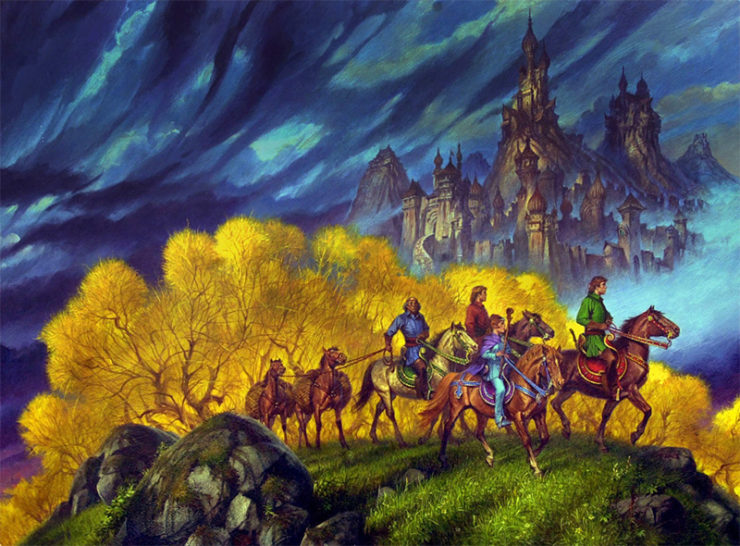
Point of fact: Mat catches a badger and sacks it for Perrin to ease later.
There are definitely owls in the Westlands, as Verin has one in her room in the Tower. And there are mentions of large snakes (likely anacondas or pythons) in the Drowned Lands north of Mayene.
It’s really interesting to think about the potential geography of Shara. I love the idea that much of it is savanna, and that there could be a rain forest.
EDIT: Can’t believe I forgot about it, but there’s also a giraffe skeleton in the Panarch’s Palace in TSR.
The Seanchan have “boar-horses” which are quite clearly described as Elephants. Additionally there are actual Lions seen in Luca’s Traveling show.
There is a dream Ter’angreal trap carved in a shape of a hedgehog and recognized by everyone as such, so hedgehogs are definitely present.
Bison are also definitely present – “a curly-haired wild bull” is the wolves’ image of Perrin.
There is only one lion in Andor, and that’s the Red Lion!
You forgot the White Lions. :)
Actually, here’s a list of every animal, vegetable and mineral mentioned in the first six books:
http://www.tsosmud.org/concordance.txt
Giraffes are either extinct or can only be found on distant landmasses: there’s an image of one on a freize in the Panarch’s Palace in Tanchico and it’s referred to as an animal that is no longer extant. Elayne and Nynaeve see it just before they find the Mercedes Benz hood ornament.
An instructive article is “Beasts of the Wheel of Time”, written by Robert Jordan himself and published in the 2001 annual of DRAGON Magazine. The article lists the following canonical animal species:
BEARS: found in black and brown varieties, and a curious off-shoot species of white-faced bears that live in the Spine of the World. There are also “king bears” which can grow to ten feet in height. They are native to southern Saldaea, the Black Hills, between the Black Hills and the Mountains of Mist and throughout the mountains.
BOARS: fairly common. Bladetusks, a hardier species, are found in the Aiel Waste, as are Pecara, a more docile species and Sand Pigs, a very timid species but dangerous if cornered.
GREAT CATS: leopards are reasonably common right across the westlands. Lions are rarer, but likewise range across the whole continent, with a smaller species living in the Aiel Waste. Ridgecats are found in mountainous regions. Sandcats are native to the Aiel Waste. Swamp cats are native to the Drowned Lands.
FOXES: red and grey foxes are common across the continent. Snow foxes can be found in the Borderlands. Black foxes are relatively rare and prized for their thick fur. They can be found between the Borderlands and Andor.
GOATS: as well as the common variety of the westlands, there are the gaellae or leaphorns (mountain goats) of the Aiel Waste and the coema or longhorns, a more docile Aiel food animal.
SHELLBACK: aka the gaoerant, this is a small herbivore native to the Aiel Waste. It is covered by scales and armoured shell segments. It can burrow underground at great speed.
RATS: Soetam are quite large rats native to the Drowned Lands, where they hunt in packs. Sorda are nocturnal rats native to the Aiel Waste, with a prediliction for defecating on anything they can’t eat.
SNAKES: Species in the westlands and Aiel Waste include the constrictor, blacklance, mountain king, scarlet puffer, hooded adder, bloodsnake, king viper, sand viper and two-step (an innocuous snake of the Aiel Waste with a lethal poison which can kill a human before they can take two steps).
@2:
Its fossilized, not just a skeleton. That’s why the OP talks about extinct animals not having time to be “re-evolutionized” within a single turning of the Wheel.
@3:
The “boar-horses” are called S’redit, and are listed in the OPs Seanchan list, although I’m unclear as to whether the OP is thinking the S’redit came over from the parallel universe with the grolm and other creatures or not. I assume that introduction of the parallel universe creatures destroyed the native ecology of Seanchan, leaving none of the original apex predators around. The elephants are big enough to not really be effected by that, however.
Overall, I’m not sure Robert Jordan gave as much thought to ecology as he did to the socio-political aspects of the Wheel of Time. Its just not important to the story he was telling.
Isn’t there also the Inn named “Easing the Badger” or some such, assumed to imply something naughty?
Pelicans were mentioned in Tear.
Moiraine catches trout cheating with the OP.
Sword forms contain animal names like heron and hummingbird.
The DO uses rats as eyes and ears, and Graendal uses a pigeon.
Hopper wants to soar like an eagle.
In New Spring Moiraine summons ants and other bugs to trouble Lan.
Perrin has to deal with weevils.
In the Blight there are creatures like Jumara (worms) and sticks.
There’s a lion in Luca’s show, and while looking at it Tuon mentions that “there are no lions with black manes in all of Seanchan” which suggests that they do have lions there, if differently colored ones.
At various points in the series, main continent people are seen eating ham, chicken, and beef. (I love the scene of Mat eating three whole chickens in one meal.) Milk from cows and goats is available, as are goose-down pillows. I would consider the domesticated animals you list as “assumed” to be pretty conclusive.
@10 birgit: I thought it was a dove Graendal used?
I love the idea there could be savanna, jungle, even tropical rain forests in both Shara and Seanchan. And considering I love lions, and big cats in general, I am very pleased by this article indeed. :)
The “Razor” that Mat bought as a gift for Tuon was clearly a Zebra
I was…puzzled by the speculative portion of this. Biomes may need particular types of animals (pollinators, detritivores, herbivores etc. etc.) to function, but why should we expect that particular Earth creatures which could survive in a biome happened to exist there in another fictional world where they’re not mentioned to be? Evolution and ecology are chance and change. I love learning about fantasy (and real) wildlife, but have trouble with this thought experiment, especially since the series is over. Unless we’re going with the idea that WoT-world is our world in a future Age.
(Mind you, this story also contains the Blight, whose ecological functionality is a giant flaming mystery for which I would really like explanations. Some animals must be able to eat some plants (even if some other plants eat them instead), but what eats which? What animals eat what? How does it support huge populations of Trollocs? Also, for what purpose were all those weird creatures made – or have they changed since going wild, from darkmagical mutation or hybridization or something? /ramblerant)
Aren’t dove and pigeon the same bird?
Leopards used to live around Ebou Dar, but left because the Ebou Dari were too touchy, or at least that’s what Mat was told by Thom, IIRC, and that’s the story I’m sticking with. So that area was suitably forested and had sufficient medium-sized prey to maintain a breeding population of leopards. Probably linked through forests with the Mountains of Mist and perhaps even the Paerish Swar – some of the stories about the Misty Mountains – things that strip your flesh from your bones – sound like medium-sized predators like leopards. (I suspect they lost out to the wolves because of the post-Trolloc War depopulation of the land: once prey population falls below a certain density, apex predators tend to vanish rather abruptly.)
I always regretted that Elayne never had the chance to shout “Forward the Pink Panthers!” in Tarabon … Robert Jordan missed out on some truly epic humor there!
I would reiterate the article I referenced above is canon information written directly by Robert Jordan himself, and may be of use in updating the article.
Given this is the underlying premise of the entire series, not to mention that Robert Jordan himself outright confirmed it both in-text and in interviews, that is a very safe assumption.
This is very intresting article. It is thought-provoking that you see Land of Madmen as tundra. I always imagine this land as totally distroyed by men, as, I don’t know, as Roshar, where animals and plants have to evolved to survive. I always belived that lots of strange creatures can be found there :)
The Land of Madmen is pretty much Australia, as Jordan said. Climactic changes and possible shifts in the tectonic plates might give it a colder climate than modern-day Australia, but there is no textual evidence of that.
Jordan didn’t seem to focus as much on the ecology/wildlife of his world (which is fine; there’s only so much you can do) but it’s fun to think about – especially in regards to places like Shara or Land of the Madmen.
Now what I would like to know is which bacterial/archaeal strains survive from age to age… ;)
Interesting article. The thing is that RJ invented different names for the animals he used. I think we barely see a zoo.
As someone said, animals as such were not important to the story
I always interpreted Randland as being basically North America, with the Aiel Waste being the Southwest. The Land of Madmen is Australia, of course, Seanchan is Asia, and Shara is Africa (“Sahara”). Lions could be in the Waste because they’re invasive from Shara.
what about the meegerling? lol
gaul told perrin about the lopinginny(a type of bird)
I haven’t read the series in a long time and in fact never finished the series. However, since we know that the freeing of the dark one was a huge cataclysm, it would not be surprising if various species were in fact wiped out. The description of the world before the fall is of a universally civilized world. Most likely exotic animals were rare, and probably only in specific wildlife preserves. With the kind of destruction implied in the opening of the prison and the wars that raged afterward, as well as the breaking of the world, I would not be surprised to find the exotics not surviving.
I hate to be the one to say it, but as awesome and meticulous a world builder as Jordan was, might we be overlooking the possibility that he might have made mistakes and was sloppy at times? Or as @@@@@8 put it, that the minutiae of the ecological aspects were simply not as important as the socio-political ones?
Every author uses tropes, cliches, and archetypes, usually for the sake of creating familiarity and flow for the reader. So a lion as our heros’ nation’s crest evokes nobility, strength, etc. but if you look deeper, what do you find but a few lions in a circus (how did they get there), and a reference (at least he was good enough to slip that in in a later book) to multiple different sub-species of lions living in Seanchan (thanks @@@@@ 11). So Jordan is more or less safe with the lions.
@@@@@15. The trope of hordes of orcish/trollish minion types living in wastelands and deserts is everywhere in fantasy. Perhaps that needs a reshuffle, but sorry to say, RJ was not the one to do it.
Additionally, in the beginning of Knife of Dreams (chapter 7 maybe?), Mat buys Tuon a ‘razor’. This is a rare Domani horse named for the way its fur meets in straight lines across its back. When reading this I had assumed that it was the equivalent of a zebra, evidence of the animal on “Randland” and not just in Shara.